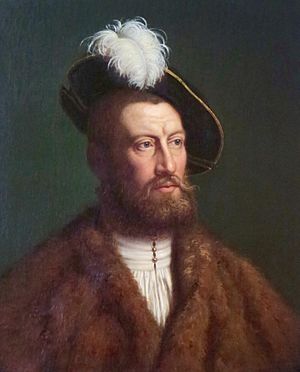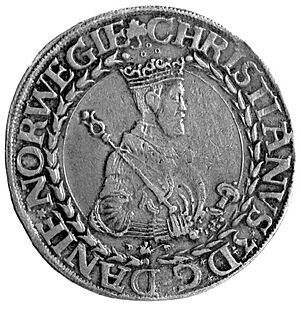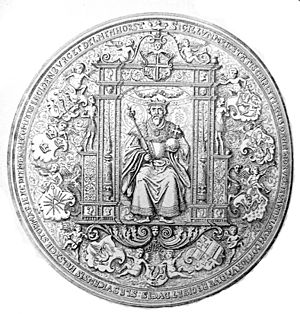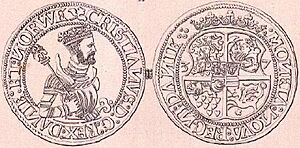Christian III of Denmark facts for kids
Quick facts for kids Christian III |
|
|---|---|
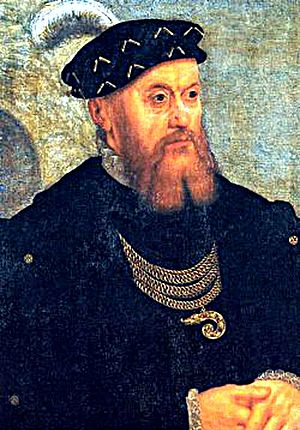
Portrait by Jakob Binck, 1550
|
|
| King of Denmark (more...) | |
| Reign | 4 July 1534 – 1 January 1559 |
| Coronation | 12 August 1537 Copenhagen Cathedral |
| Predecessor | Frederick I |
| Successor | Frederick II |
| King of Norway | |
| Reign | 1537–1559 |
| Coronation | 12 August 1537, Copenhagen |
| Predecessor | Frederick I |
| Successor | Frederick II |
| Duke of Schleswig-Holstein | |
| Reign | 1533 – 10 April 1559 |
| Predecessor | Frederik of Denmark |
| Successor | Frederick II |
| Born | 12 August 1503 Gottorf Castle, Schleswig, Denmark (now Germany) |
| Died | 1 January 1559 (aged 55) Koldinghus, Kolding, Denmark |
| Burial | Roskilde Cathedral, Zealand, Denmark |
| Spouse | |
| Issue | Anna, Electress of Saxony Frederick II, King of Denmark and Norway Magnus, Duke of Holstein John II, Duke of Schleswig-Holstein-Sonderburg Dorothea, Duchess of Brunswick-Lüneburg |
| House | Oldenburg |
| Father | Frederick I of Denmark |
| Mother | Anna of Brandenburg |
| Religion | Lutheran |
| Signature | |
Christian III (born August 12, 1503 – died January 1, 1559) was the King of Denmark from 1534 and King of Norway from 1537 until his death. He was the first king of Denmark-Norway. During his time as king, Christian III made Lutheranism the official state religion in his kingdoms. This was a big part of the Protestant Reformation. He also created strong connections between the church and the crown.
Contents
Early Life and Education
Christian was the oldest son of Frederick I of Denmark, who would later become king. His mother was Anna of Brandenburg. He was born at Gottorf Castle in Schleswig. This castle was his father's main home.
When Christian was ten, his mother passed away. Four years later, his father married Sophie of Pomerania. In 1523, his father, Frederick I, became King of Denmark. He took the place of his nephew, Christian II.
Young Prince Christian's first public job was to help bring Copenhagen under his father's rule. Copenhagen had supported the previous king, Christian II. Later, as a leader in the regions of Holstein and Schleswig, and then in Norway, Christian III showed he was good at managing things.
How His Faith Shaped Him
Christian's teachers, Wolfgang von Utenhof and Johann Rantzau, were strong supporters of the Protestant Reformation. They taught him about the new ideas. In 1521, when he was traveling in Germany, they encouraged him to attend the Diet of Worms. There, he heard Martin Luther speak. Luther's ideas really interested him.
Prince Christian openly supported Lutheran views. This caused problems with the Roman Catholic-controlled State Council (Rigsraad). It also caused issues with his father, who was more careful. At his own court in Schleswig, Christian tried to bring in the Protestant Reformation. He faced opposition from the bishops. In 1528, he made the Lutheran Church the official church of Schleswig-Holstein.
Becoming King of Denmark
A Difficult Start to His Reign
After his father died in 1533, Christian was named king of Denmark. This happened at a meeting in Rye, a town in eastern Jutland, in 1534. However, the State Council, which was mostly Catholic bishops and nobles, did not want Christian as king. They wanted to bring back Christian II.
Instead, they chose Count Christopher of Oldenburg to rule. This led to a two-year civil war from 1534 to 1536. It was called the Count's Feud (Grevens Fejde). This war was a fight between Protestant and Catholic groups.
Changes After the War
Christian III won the war. But it was hard for a king who had fought to gain his kingdom to immediately trust the people who had fought against him. Christian had received help from German nobles to win Denmark. These German nobles had led his armies and helped with his plans.
The first six years of Christian III's rule saw a struggle between Danish leaders and German advisors. Both groups wanted to influence the king. The Danish side managed to get a rule that only native-born Danes could hold the highest positions. However, the king's German advisors still had a lot of power early in his reign.
Christian III's victory meant the end of Catholic Christianity as the main religion in Denmark. Even though Catholics still had power in the State Council, Christian III ordered the arrest of three bishops on the Council in 1536.
The war had left Christian with huge debts. To pay these debts, he took over lands belonging to the Church. These lands had been farmed by peasants who were free from duties to nobles.
Christian's Protestant policies led Denmark to officially establish Lutheranism as the Danish National Church (Folkekirke). This happened on October 30, 1536. The new State Council adopted the Lutheran Ordinances. These rules, created by German theologian Johannes Bugenhagen, explained how the church should be organized and what religious practices were allowed. Monasteries and convents were closed, and their property was taken by the crown. The amount of land owned by the king grew from one-sixth to 60% after these changes.
In 1537, Christian's actions in Norway made it a hereditary kingdom. This meant the king's children would automatically inherit the throne. Norway became closely linked with Denmark until 1814. He also made Lutheranism the state religion in Norway. On September 2, 1537, he appointed Gjeble Pederssøn as Norway's first Lutheran bishop.
Later Years of His Reign
Keeping the Peace

Christian III faced threats from Emperor Charles V. Charles V supported the claims of Christian II's daughters to the Scandinavian thrones. This made Christian III realize he needed to make his own people happier. He began to rely more on Danish nobles. In 1542, the Danish nobility agreed to give Christian a part of their property to help pay off his large debts to German soldiers.
Christian III's foreign policy focused on alliances with German Protestant princes and France. This helped balance the ongoing hostility from Charles V. War was declared against Charles V in 1542. Christian used a strong tactic: he closed the Sound to Dutch ships. This was so effective that the Netherlands forced Charles V to make peace with Denmark-Norway. This peace treaty was signed at Speyer on May 23, 1544.
Building and Helping Others
Christian III's later years were focused on keeping the peace established by the 1544 treaty. He chose not to join the Schmalkaldic War in 1546. He also helped settle disagreements between the Emperor and Saxony after a battle in 1553.
In 1549, he started building Landskrona Citadel. He also rebuilt Sønderborg Castle, changing it from a fortress into a beautiful four-winged castle in the new Renaissance style between 1549 and 1557. In 1555, he successfully helped the English Bible translator and bishop, Miles Coverdale. Coverdale had been in prison for two and a half years by the Catholic Mary I. Christian's help led to Coverdale's release, and he was allowed to leave England.
Christian III died on January 1, 1559, at Koldinghus. He was buried in Roskilde Cathedral. His tomb was designed by the famous sculptor Cornelis Floris de Vriendt.
Family and Children
Christian married Dorothea of Saxe-Lauenburg on October 29, 1525. She was the daughter of Magnus I, Duke of Saxe-Lauenburg. Christian and Dorothea had five children:
- Anna of Denmark (1532–1585), who married Augustus, Elector of Saxony.
- Frederick II of Denmark (1534–1588), who became the next King of Denmark and Norway.
- Magnus of Denmark (1540–1583), who became Duke of Holstein and later a king in Livonia.
- Hans of Denmark (1545–1622), also known as John the Younger, Duke of Schleswig-Holstein-Sonderburg.
- Dorothea of Denmark (1546–1617), who married William, Duke of Brunswick-Lüneburg. She was the mother of George, Duke of Brunswick-Lüneburg.
Memorials
In 1579, Frederick II asked Dutch artists to build a memorial for Christian III at Roskilde Cathedral.
Christian III also has an honorary stone at the Walk of Fame in Landskrona. Sweden's King Carl XVI Gustaf opened this Walk of Fame in 2013.
Images for kids
Related reading
- Øystein Rian (1997) Danmark-Norge 1380–1814 (Universitetsforlaget) ISBN: 9788200228455
See also
In Spanish: Cristián III de Dinamarca para niños


